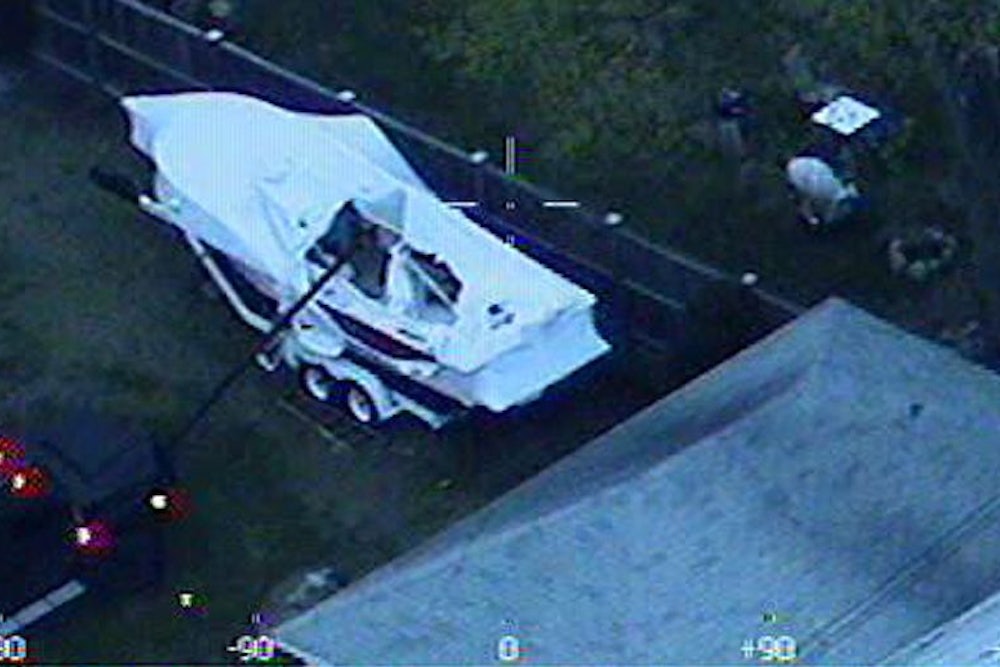I had not been following yesterday's manhunt in detail, so when last night I learned, from a friend who was being a more diligent Twitter fiend than I, that Dzhokhar Tsarnaev was in a boat, and then that he was surrounded, and then that we had caught him, it seemed to me merely like nice symmetry. What had begun a little after noon on Monday, with the fatal explosions at the Boston Marathon, concluded around sundown on Friday. Nice when things work out like that.
Of course, aesthetics and happenstance had nothing to do with it. Tsarnaev, 19, was found when he was found—which is to say, was found at all—for precisely one reason: Boston authorities lifted their “shelter in place” order, or lockdown, which had been in effect since the early morning. Right after Boston Mayor Deval Patrick announced life could return to a slightly less un-normal state, Watertown resident David Henneberry stepped out into his yard, noticed that something was amiss with the tarp that covered his boat, and called the police.
Throughout the day, I was struck by the problematic implications of the lockdown. Had not Tsarnaev just proved that he could continue to terrorize, forcing the residents of Watertown, Cambridge, Newton, and, initially, Boston itself to stay in their homes as SWAT teams swarmed over residential neighborhoods? Empty streets provide their own kind of trauma. “There is symbolism when one of the U.S.’s largest cities paralyzes itself in face of terrorism,” wrote a Jerusalem Post reporter living in Boston, who noted that the cafes of Jerusalem and Tel Aviv are frequently open for business mere hours after terrorist attacks. (Technically, Patrick's “order” was only a request; he couched it in the language of both personal security, as in, “We’re gonna need the public to help us help them stay safe,” and of aiding the manhunt, “to assist law enforcement by following those simple instructions.”)
I tend to fall more on the communitarian than libertarian sides of these sorts of arguments. In the case of the evacuations that have been ordered in New York City each of the past two years for fear of dangerous storms, I have believed strongly that those in evacuation zones should get out, because staying could put not just themselves but emergency responders at risk as well as divert crucial resources, besides which there was no larger benefit to staying: they were not going to inhibit the storm by standing their ground; and there isn’t really a “statement” in not being pushed around by a natural disaster in the same way that there is, in fact, a statement in refusing to be overly intimidated by a 19-year-old alleged cop-killer and terrorist.
As it turns out, eyes on the street were exactly what was needed: an individual citizen freely going about his business is how the police were tipped off. At least one author noted yesterday, before the capture, that the lockdown created the antithesis of Jane Jacobs’ ideal city, which is famously free and open and ensures its security by the very fact that there are many people on the streets (which is why she loved sidewalks and storefronts and loathed enclosed public housing projects). Certainly Tsarnaev’s capture was a strong data point for Jacobs-style urbanism.
But learning how the killer was found, my mind went to a bit more abstract place, namely to that famous Oliver Wendell Holmes “marketplace of ideas” Supreme Court dissent that you probably read in high school. In a bit of reasoning he actually stole from John Milton, Holmes, son of Beacon Hill, at first defended free speech on basically utilitarian grounds, cheekily noting that the most efficient way to suppress “bad” ideas is to let them into the open, where better ideas can defeat them. It does not always happen this way—less than 15 years after Holmes’ dissent, some pretty bad ideas were accepted by the majority of Germans—but, as Holmes said, in a flourish that both put a stamp on and transcended the philosophy he had just laid out: “That, at any rate, is the theory of our Constitution. It is an experiment, as all life is an experiment.”
There is no way to definitively play out the what-ifs. Authorities might not have coaxed a lockdown, people might have walked around Watertown, and somebody might have gotten hurt. Conversely, authorities might have kept the lockdown longer than they did, and Tsarnaev, who was taken to a hospital for urgent treatment, might have sat in the boat even longer, undiscovered, and bled to death. We don't know. The problem with the lockdown, as a matter of principle, isn’t that it could have prevented us from capturing Tsarnaev alive. Rather, the way Tsarnaev was captured alive is further suggestion that life in America is a Constitutionally codified experiment, and that the worst time to suspend experiments is when you don’t have all the answers.
